The Westfjords is the kind of place that makes you question whether you’ve actually driven into some kind of screensaver or simply into something out of a Viking fever dream (skál!) This massive, mountainous, and fjord-filled peninsula in the northwest corner of Iceland is the least visited region in the country. And that, dear traveller, is exactly why you need to go. Be prepared, as if you don’t book I’m about to give you a double dose of FOMO.
Here, the roads are windier, the cliffs are steeper (they will put a few extra hairs on your chest, for sure), and the sense of isolation a little more real. No endless convoy of tourists chasing waterfalls. It’s just raw nature, dramatic landscapes, the most incredible puffin peninsula, an empty huge red beach wonder, natural hot springs, and the most incredible scenery Iceland has to offer. In case you can’t tell, I’m a fan, and by the end of this guide you will be too.
What Makes the Westfjords So Special?
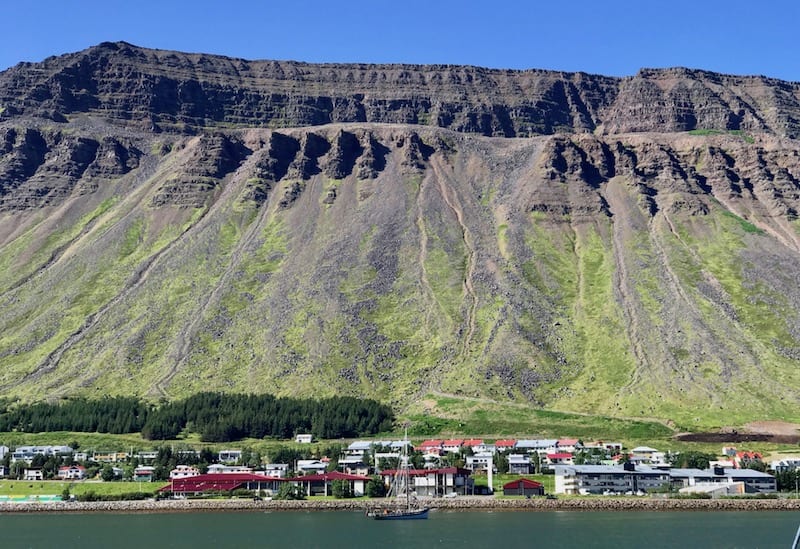
Let’s start with the obvious. The fjords themselves. It might be a bit of a spoiler that with the region being named ‘The Westfjords’, there might be a fjord or two, or actually nearly 50 in reality. The Westfjords is home to endless snaking coastlines that curve like they were drawn by a drunken Norse god with a fondness for scribbling, that make the drive that extra brit more spectacular, and maybe a dose of sweaty palms along some of the steeper incines.
Add in waterfalls that explode out of cliff faces and even one that drapes down as a jilted giantess according to folklore, beaches the colour of toasted cinnamon, and remote hot springs that would make a Roman emperor blush.
It’s not just the landscapes, though. There’s a rhythm here that’s different from the rest of Iceland. Slower. Wilder. Like you’re constantly on the brink of discovering something that most people miss. It’s often a detour out of the normal traveller’s trails of the Ring Road due to the time the Westfjords takes to get to (not to mention, circumnavigate). In fact, less than 10% of travellers explore what I would say is probably the most Iceland-uncut region you can visit (also, there’s way more sheep than people here).
Is the Westfjords Worth the Detour?
If your version of adventure is hitting the major stops, getting the photo, and moving on, then maybe not (only Dynajandi waterfall would be the exception, here).
But if you like taking the long way round, love dramatic coastlines, and think the best stories come from places fewer people go, then the Westfjords is an absolute no-brainer.
How to Get to the Westfjords
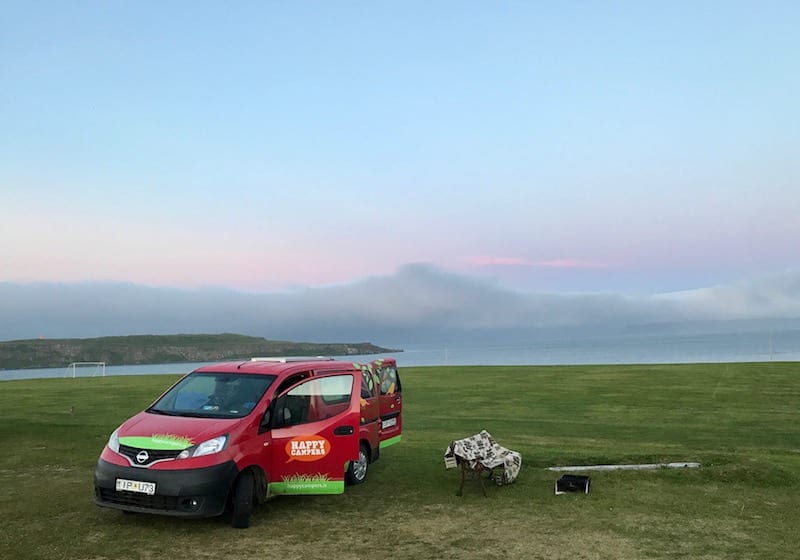
Getting to the Westfjords is where the adventure really begins. This isn’t one of those hop-on-a-plane-and-you’re-there situations. It’s a journey that sets the tone for the wild landscapes ahead. And, I may be bias, but if you’re on a Happy Campers travel guide, I’m pretty confident you’re as big a fan of the open road adventures as me.
The Westfjords don’t exactly roll out a red carpet, but they do offer some of the most stunning, off-the-grid routes in the country. Whether you’re zigzagging along coastal cliffs or boarding a ferry with your camper from Stykkishólmur like you’re in a Nordic version of Mario Kart, every kilometre (or mile for my fellow Brits, and Americans) is 100% part of the experience.
It’s a rugged region, incredibly remote, and occasionally a bit hairy here and there (especially the drive down to Rauðasandur beach). And that’s not even mentioning the complete isolation hiking in the Hornstrandir region, home to the ever-sought-after Arctic Fox.
Driving from Reykjavík to the Westfjords
First off, give yourself time, and then a bit more time on top of the time. Getting from Reykjavík to the Westfjords isn’t a quick jaunt. You’re looking at a solid 5-hour minimum drive (assuming you follow the speed limit like we all do..), depending on your route and whether you stop to take in the views (you don’t need ADHD to get distracted in Iceland, trust me).
There are two main routes: the inland route through Borgarnes and Búðardalur, or the more coastal journey hugging the fjords. Both are scenic, and both are slow. But, that’s part of the charm.
Check SafeTravel and your journey’s road conditions before you go. You can never be too careful in a bi-polar weather country, especially in this heavily mountainous region.
Ferry Options (Baldur Ferry & Alternatives)
If you want to cut some driving time and add a boat to your trip, then take the Baldur Ferry from Stykkishólmur on the Snæfellsnes Peninsula to Brjánslækur in the Westfjords. And don’t stress it, you can even take your campervan aboard.
Check Seatours for schedules. Just note that this route is only operational in summer. But, this is fine as driving in the Westfjords during the winter months is usually not advisable by myself and the team.
When Is the Best Time to Visit?
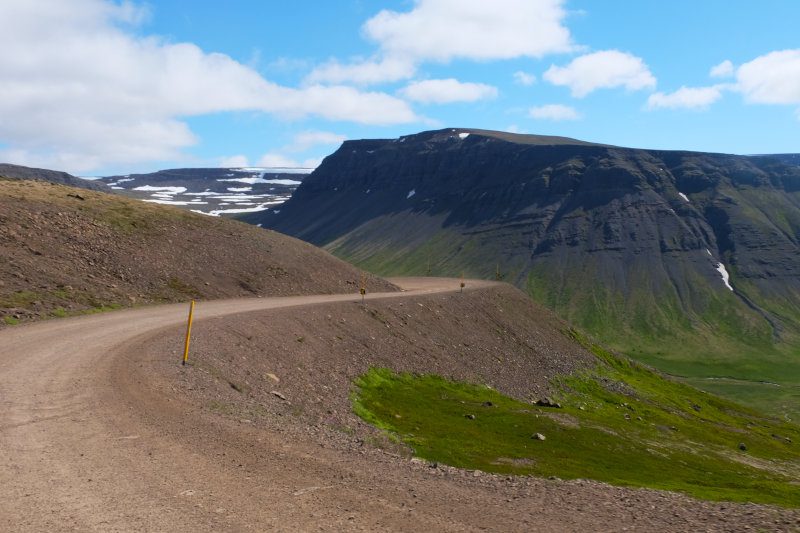
Summer, hands down. June to August gives you the best shot at open roads, accessible mountain passes, and weather that just tends to play ball a bit more, though that’s not to say it won’t still be unpredictable from time to time.
Spring and early autumn can work if you stick to lower areas, but winter? To reiterate my sentiment from above again in a Mafiosa way, forget about it unless you have a backup snow plough ready to pick you up.
The Best Things to Do in the Westfjords
You don’t come to the Westfjords to tick off a top ten list and head back to the city. You go there to feel small amidst the vastness of the giant-esque nature that surrounds you. This region is a playground for those who prefer puffins to people and hot springs over hotel bars.
What follows are the main stop-offs I’d recommend not missing if you’ve by now made the correct decision to explore the Westfjords of Iceland.
Dynjandi Waterfall: The Jewel of the West
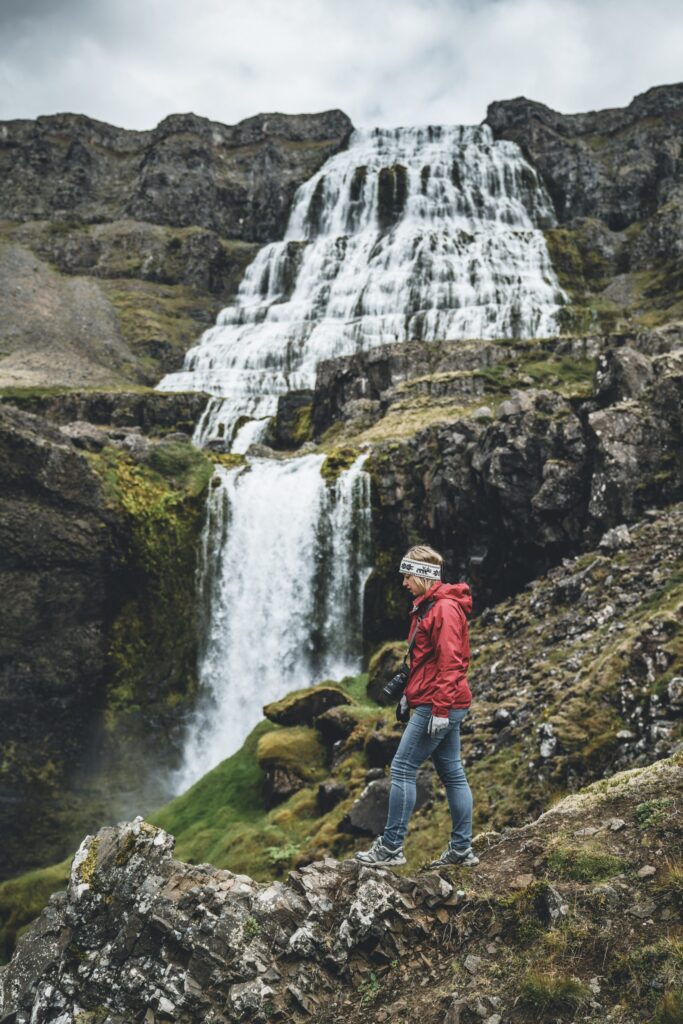
Dynjandi is a thunderous, tiered monster of a waterfall that roars down a cliff face like a bridal veil caught in a hurricane. Icelandic folklore even tells the tale of how Dynjandi is in fact the bridal veil of a jilted giantess, whose wails from the falls can be heard indefinitely in sorrow. From my perspective, it is by a country mile the best waterfall in Iceland.
The cascade stretches over 100 metres in height, starting wide at the top and narrowing as it falls, giving it a very unique elegance that seems almost sculpted into the mouth of the fjord. There’s a trail that leads right up to its base, where the mist hits you like a refreshing slap to the face, but in a good way, I’d add.
It’s also a great overnight stop if you’re campervanning. The road to get there is an adventure in itself, winding through valleys and fjords with views that demand you pull over every ten minutes (ok, two-five). You’ll find a small, rustic campsite nearby with one of the best wake-up calls in Iceland. And in case you haven’t caught my drift, I mean the sound of Dynjandi thundering in the background while you boil your morning coffee.
Rauðisandur: The Red Sands of Iceland
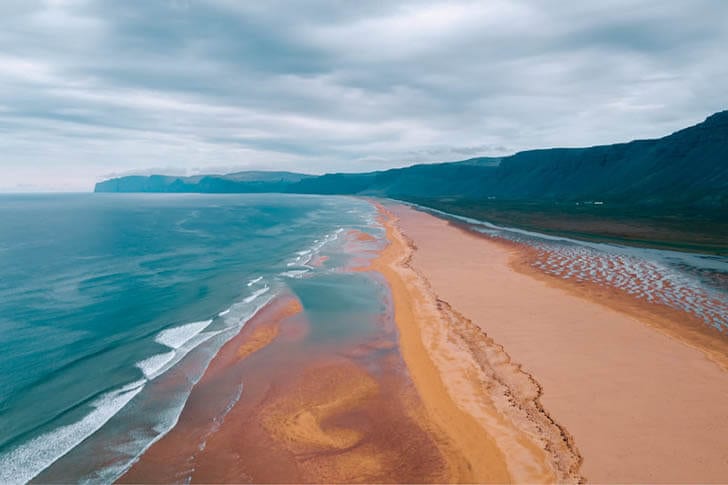
Most Icelandic beaches are black. This one is a deep, golden-red. A sweeping stretch of sand so warm in tone it almost tricks you into thinking you’ve stumbled into some kind of Mediterranean region of the country, until the breeze hits you with that signature Icelandic chill.
It stretches for miles and is usually empty, save for a few birds and the odd philosophical sheep here and there, bleating on every now and again. You can reach it by a rough gravel road that adds to the sense of remoteness, and once you’re there, it’s easy to feel like you’ve got your own private coastline, if even just for a couple of hours.
It’s ideal for a peaceful picnic, a beachside wander, or contemplating life like you’re in an indie film that never quite got funding (probably most of them).
Látrabjarg Cliffs: Puffin Paradise
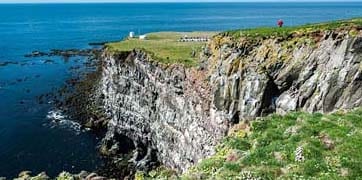
Welcome to the edge of Iceland. Literally. These towering sea cliffs mark the westernmost point of Europe, stretching 14 kilometres along the coast with drops that’ll make your knees wobble just from looking down. I’m very much afraid of heights and cliffs, come to think of it, so perhaps you’ll handle this location better than me.
In summer, it transforms into one of the best puffin viewing spots in the country. Thousands of seabirds nest in the grassy ledges, including razorbills and guillemots, but the puffins are the real stars.
You can get ridiculously close to the birds (they’re oddly relaxed and curious when encountering travellers), and they’ll happily pose like they’re working a part-time modelling gig for nature documentaries, which is even more fun for those of you who can mimic the David Attenborough voice. Just don’t get too close to the edge, as it really is a long way down.
The panoramic views from the top stretch out across the North Atlantic, and on a clear day, you might even spot a whale or two in the waves below. It’s also a prime sunset location if you’re campervanning in summer, when golden hour can feel like it lasts all night due the fascinating midnight sun.
Ísafjörður: The Capital of the Westfjords

This small but lively town is the heart of the region. It’s got charming houses, great fish soup, the occasional music festival, and a pretty unreal airport runway, oddly enough. But it’s also home to a surprising creative spirit, with art installations popping up in old fish warehouses and bakeries that double as galleries.
Ísafjörður has the kind of easy charm that lets you slow down. You’ll find grocery shops, gas stations, and even a proper coffee with some local baked goods (I’d recommend a Snúður). It’s also a gateway to remote areas like Hornstrandir and the perfect place to restock or reboot between adventures.
Base yourself here if you want a bit of civilisation between your wilderness stints, and a chance to chat to a few humans that aren’t made of wool. Also, the campsite here has a very tall waterfall right by it with the stream running right by your camper, which is a really relaxing way to drift off (but try not to wet the bed).
Hot Springs to Soak In (Hellulaug, Reykjafjarðarlaug & More)
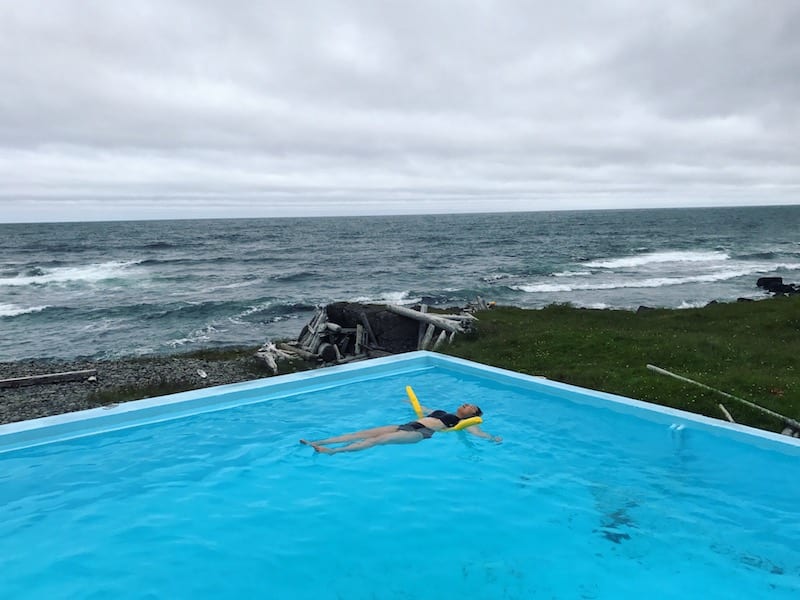
Hot springs in the Westfjords are well worth a dip if you have the time. Hellulaug sits right by the sea, hidden behind a car park with no signs or flashy entrances, just steaming water and ocean views that hit differently when the mist rolls in.
In contrast, Reykjafjarðarlaug is tucked up in a valley, surrounded by hills that were crafted for solitude. There’s an old concrete pool here beside a river and a hot spring just up the path, both free to use and rarely crowded.
Further afield, you’ll find pools like Krossneslaug, perched right on the edge of the Arctic Ocean, which has that just-you-and-nature kind of vibe, but is frequently papped for social media (and for good reason).
You’ll be soaking with views that beat any spa you’ve paid for, and the only membership you need is the ability to turn up and not drop your towel in the wind.
Hiking Trails & Wild Nature (Hornstrandir Nature Reserve)
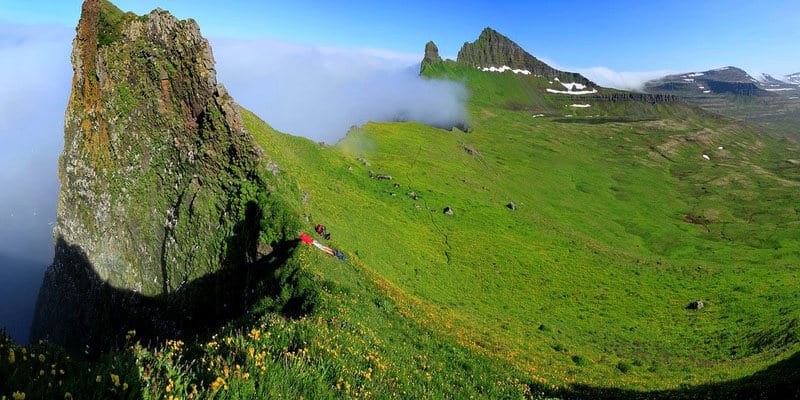
Hornstrandir is where the roads end and the wild begins, in a region where no cars are allowed. Just hiking boots, backpacks, and a sense of awe that only comes from complete disconnect, often used in the summer with Icelanders attempting a digital detox (or so they message to let me know that’s the reason).
This remote peninsula is only accessible by boat from Ísafjörður or Bolungarvík, and once you arrive, you’re entirely at the mercy of nature. No phone signal. No shops. Just vast, untouched terrain, steep fjords, and the sound of silence broken only by the wind and the occasional Arctic fox, which you’ll want to spot.
Hiking here can range from day treks to multi-day expeditions through old farming routes and abandoned villages frozen in time, from the south to the north side, where a boat will pick you up and take you back to civilisation. If you’re up for it, wild camping is allowed and encouraged, just make sure to follow the “leave no trace” rule like it’s gospel, and avoid any unnecessary dirty protests.
This is one of the last true wilderness areas in Europe, and spending even a night here will make the modern world feel very far away. And, after all, that is kind of the point.
Arctic Foxes & Wildlife Watching
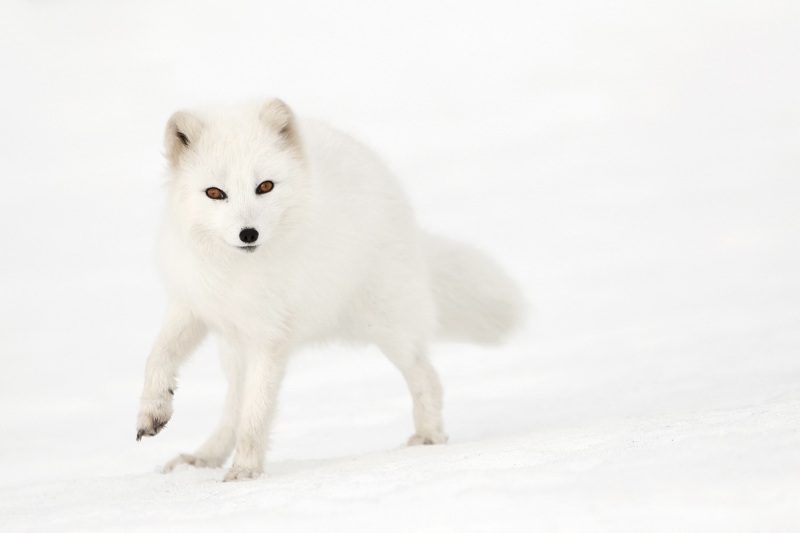
The Arctic fox is Iceland’s only native land mammal, and the Westfjords is where they still rule. Believe it or not, they’ve been here since the last Ice Age, thriving in the rugged terrain long before humans showed up with maps and TikTok. You’ve got your best chance of spotting one in the Hornstrandir Nature Reserve, where they’re known to trot casually across hiking paths if you’re lucky. For the more eagle-eyed of you, look out for burrows and the odd tuft of hair sticking out.
They come in two colour variations: the common dark morph and the rarer white morph, both equally skilled at popping out of nowhere just as you’ve put your camera away. These curious little creatures are shy but not impossible to see, especially if you’re quiet, patient, and even better if you have a long focal lens.
Beyond the foxes, the coastline offers prime real estate for birdwatchers. Fulmars, guillemots, arctic terns, and of course, puffins are everywhere. Seal colonies haul out on remote beaches, and if you scan the ocean long enough, a Humpback whale’s fluke might just break the surface and make your day. It’s a wildlife haven that doesn’t need fences or feeding times.
And, if any of you travel here and unfortunately don’t get to spot a cunning Arctic fox, then I can happily send footage of my house cats hunting pounce, which oddly replicates her Northern neighbours.
The Westfjords Heritage Museum and Cultural Stops
If you want to understand the soul of this region, it’s worth a visit to some of the museums. The Westfjords Heritage Museum in Ísafjörður is excellent, packed with maritime relics, historic boats, and tales of a time when fishing was less about tech and more about guts, salt, and stubbornness. It’s housed in an old warehouse and captures daily life from centuries past in a way that makes you appreciate your heated campervan even more.
Also, check out the Sea Monster Museum in Bildudalur (Skrímslasetrið) for something weirder. This place leans right into Icelandic folklore, showcasing reported sightings of terrifying sea creatures with wild diagrams and dramatic eyewitness accounts that seem like they were ripped straight from a Viking Netflix series. I personally place this museum in oddness and uniqueness on par with the Penis museum in Reykjavík (no one asked for it, but it’s definately not worth missing).
Both spots add an extra layer to your trip (part history lesson, part story to tell your kids when you can’t get them to sleep), and they’re a great excuse to step inside if the weather turns a little worse for wear.
Kayaking, Boat Tours & Sea Adventures
Whether you’re paddling through fjords, wanting to take your chances spotting a nautical beast, or joining a fishing trip, there are plenty of ways to get out on the water. Kayaking is a standout experience here, especially in places like Ísafjarðardjúp, where the still waters and surrounding cliffs make you feel like you’re gliding through a Norse saga.
There are guided trips for beginners and more hardcore multi-day versions for those who think a sore shoulder is a badge of honour like me. Wildlife cruises offer another way to explore, often spotting puffins, seals, and some whale species like the Humpback, Minke, or Blue whale in the deeper fjords.
Fishing tours run straight from small harbours, and if you’re lucky, you’ll land a cod bigger than your arm, as well as learn a few colourful Icelandic phrases from the skipper while you’re at it.
Just dress for spray. And cold. Mostly cold. And possibly a bit of fish smell. I highly recommend you consider one of these bucket list options in this unique part of the world while you have the chance (particularly if the weather looks good).
Westfjords Road Trip Planner

Planning a road trip through the Westfjords is about slowing down and surrendering to the wild rather than keeping yourself to a pristine travel schedule. This region doesn’t hand over its secrets quickly, but for those who take the time, it’s one of the most rewarding drives in all of Iceland.
You can expect narrow roads, great views, and the occasional car showdown in the middle of the road. Every kilometre brings something unexpected, and your campervan becomes your ticket to the edge of the map. Treat her right and she’ll treat you right.
Suggested Itinerary: 3, 5, and 7 Days
3 Days: Base yourself in Ísafjörður and explore the surrounding area at a relaxed pace. Spend your first day driving to Dynjandi, soaking in the views, and grabbing a spot at the nearby campsite at the base of the falls. On day two, set out early for a full-day round trip to Látrabjarg cliffs with a quick stop at the red sands of Rauðisandur if you’ve got the time and energy (assuming you packed enough coffee). Wrap up with a mellow day in Ísafjörður, stroll around the harbour, consider checking out the Heritage Museum, and treat yourself to a great fish soup.
5 Days: Extend your trip to include Patreksfjörður as a base for two nights. This allows for a more leisurely pace when visiting Látrabjarg and Rauðisandur, plus a good soak in Hellulaug without feeling rushed. You can also explore a few lesser-known waterfalls and cheeky detours without having to race against the late evening hours. Start and end in Ísafjörður, but give yourself a bit more time to linger.
7 Days: This is enough time to go full explorer mode. You’ll have time to do the full loop of the Westfjords, take the time to do several detours, and even hop on a boat to Hornstrandir if you’re feeling adventurous. Stay in Ísafjörður, Patreksfjörður, and one more wild card spot of your choice, maybe near Krossneslaug or even the eerie calm of Hesteyri on Hornstrandir (I highly recommend this stop and hiking to the old abandoned whaling station a little further down the coast). You’ll get waterfalls, wildlife, hot springs, history, and a lot of extra added adventure time to your travels. And, somewhat crucially, you’ll do it all without experiencing even one rushed breakfast.
Top Westfjords Routes for Campervans
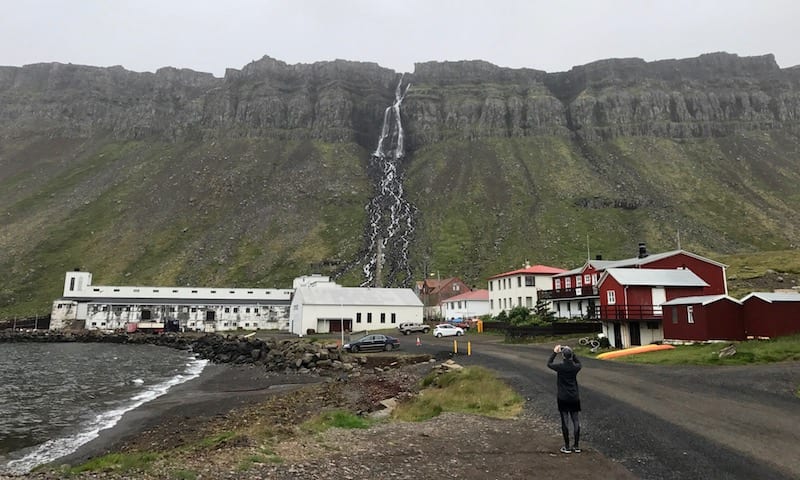
Stick to Route 60 and Route 62 to see the main highlights of the region. These routes weave through some of the Westfjords’ most jaw-dropping scenery, including towering fjords, cliff-hugging passes, and deep coastal valleys carved from the last ice age.
There are also fewer F-roads in the Westfjords that you’ll need to dance with. However, like everywhere in our fun little Atlantic rock, weather and road conditions can change quickly, especially on the more remote legs of your journey. Even the so-called main roads are often gravel, with hairpin bends that are designed more for goats than campervans at points.
The roads are gravel in a lot of parts of the journey and the further drive into this region the fewer other vehicles you’ll encounter. So take it slow, enjoy the ride, and enjoy a rare bit of solitude from your almost certainly more populated life at home.
Campsites in the Westfjords: Where to Stay
There are plenty of camper-friendly spots in Patreksfjörður, Ísafjörður, and near Dynjandi. Most campsites come fully equipped with hot showers, kitchen shelters, electricity hookups, and even laundry machines for when your socks start staging a rebellion (I’ll be able to smell them while writing from Reykjavík). Others are beautifully simple. They’re quiet, grassy clearings tucked beside a fjord with basic amenities alongside beautiful views.
Dynjandi’s nearby campsite is famously picturesque while it sits at the base of what I consider the best waterfall in Iceland (and there are over 10,000 of them), while Ísafjörður offers a more social setup with easy access to shops and cafes. Patreksfjörður has a great family-friendly campground with a short walk to restaurants and the local pool if you fancy a soak with the locals.
Just remember: campsite services vary wildly, so it pays to check ahead and carry a little extra water just in case your dream spot is more moss than amenity.
Fuel, Groceries & Supplies: What to Know Before You Go
Stock up in the proverbial “bigger towns” like Ísafjörður or Patreksfjörður where you’ll find supermarkets, petrol stations, and even the holy grail of Icelandic travel: Bónus (it’s that Pig logo supermarket). Once you’re travelling deep within the fjords, you’re often hours from the next shop, and you’ll wish you took advantage of the supermarket in the last town no matter the state of it.
Also, top up your fuel tank every chance you get. Petrol stations are few and far between out this far in the abyss. Distances are deceptive out here, and you don’t want your future fjord profile picture photo op interrupted by the reality of calling for fuel in a place with no mobile reception (another reason to always drive at the speed limit…not that you needed one).
Hidden Gems in the Westfjords
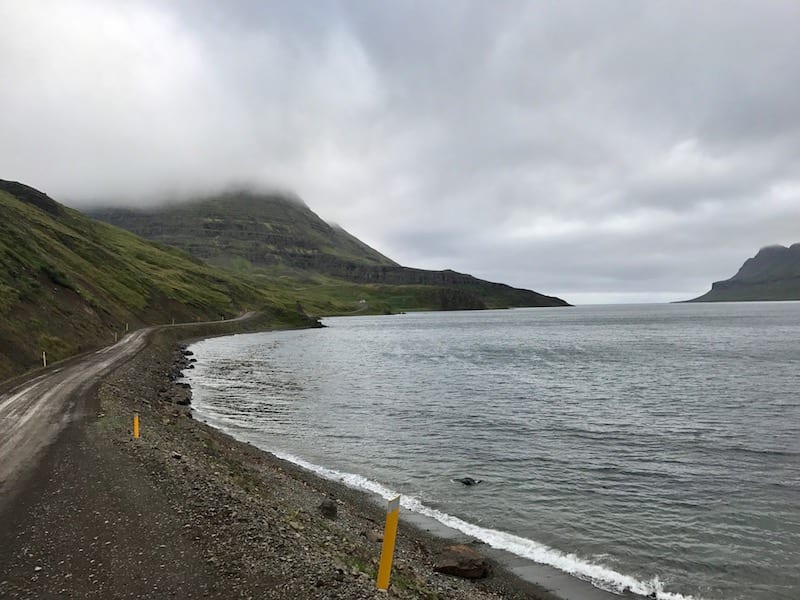
Some corners of the Westfjords aren’t in any guidebook and definitely don’t show up on roadside signs. But, we say the same thing about the Northern Lights, and that’s exactly what makes them worth hunting for.
These are the places you stumble upon by accident or hear about from a local if you’re an expert at eavesdropping and being nosy in a restaurant like me. They’re not flashy. They’re not famous. But they’re the kind of places you’ll be talking about long after your trip is over.
If the main attractions are the headline acts, think of these as the deep cuts for true Iceland fans.
Krossneslaug: Remote Pool at the Edge of the World
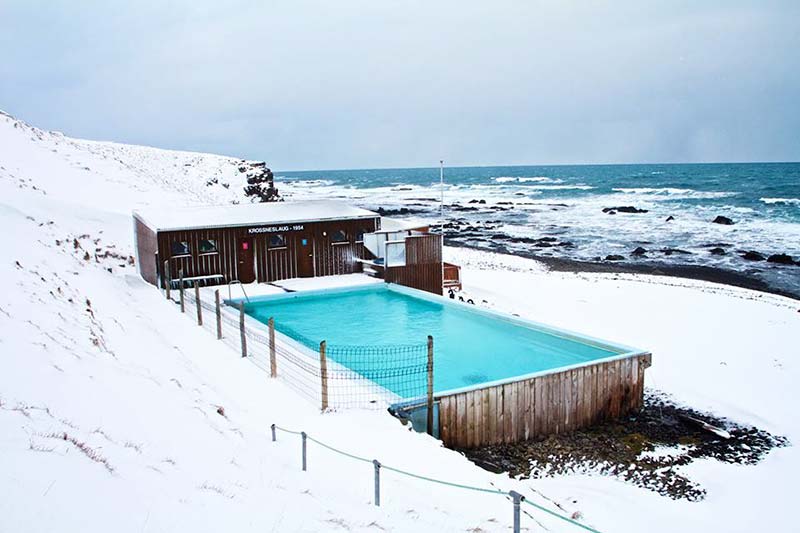
This geothermal pool sits right on the edge of the Arctic Ocean. It’s remote, wild, and the views are something else. You’ll need to drive a long, winding gravel road past steep walls of fjord, waterfalls, and increasingly dramatic scenery to reach it, but when you do, it’s like unlocking a secret level of Iceland. The pool itself is simple and unfussy, it’s just a stone basin filled with warm, mineral-rich water. No changing rooms (perfect the towel technique), no gift shop, no noise. Just the ocean in front of you and mountains at your back. It very much feels like you’re soaking in the sky while the Arctic wind tries (and fails) to bother you.
The Abandoned Village of Hesteyri
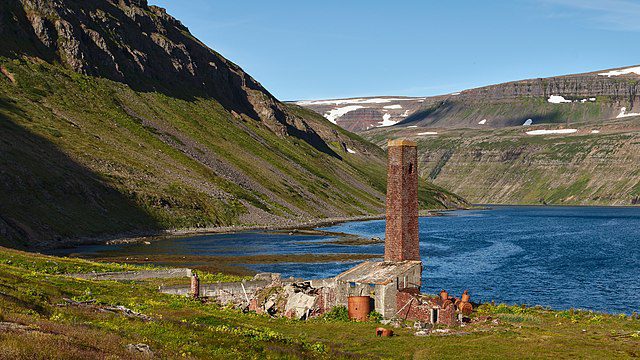 Photo Credit: Rob Oo via Wikimedia C.C.
Photo Credit: Rob Oo via Wikimedia C.C.
Accessible only by boat, Hesteyri is an interesting mixture of haunting and beautiful. It’s a place where time seems to pause, and the silence feels almost theatrical. You’ll find old turf houses gently sagging into the mossy landscape, remnants of a once-thriving village that was abandoned in the mid-20th century. There are no roads, no cars, and certainly no corner shops to visit or grab a keychain from. It’s just the rustle of the wind and the occasional creak of wood that hasn’t seen a hammer in decades, with a couple of residents who on some tours offer a view of their homes and a taste of their delicious pancakes.
Today, hikers and history lovers come here for solitude, birdwatching, and to explore the remnants of a once past community (including the remains of the abandoned whaling station). If you’re into places that feel like they’re halfway between folklore and a really well-shot horror film, Hesteyri is calling. But remember, you can take a tour that just gives you half a day’s experience and then straight back to the hustle and bustle (definitely not) of Ísafjörður.
Fossfjörður & Secret Waterfalls
Blink and you’ll miss them. Tiny waterfalls tucked into fjords that barely have names and don’t feature on any map, not even Google Maps. These aren’t the thundering showstoppers like Dynjandi, they’re quiet, unassuming cascades that sneak down moss-covered cliffs or spill gently over roadside ledges.
Some are so close to the road you could boil your morning coffee beside them. Others require a short scramble or a curious wander off the beaten track. They’re perfect spots for a peaceful pause, a feet-dip, or one of those “I found this” moments that nobody else on your Instagram feed will recognise. In part, this is because tagging a cool waterfall that isn’t well-known, is well, not easy or possible, which makes it all the more enjoyable to find, in my opinion. Keep chasing waterfalls to conflict with TLC’s previous words of wisdom.
The Witchcraft Museum in Hólmavík
Learn about Icelandic sorcery, magical staves, and the eerily detailed process of crafting necropants, which are pants made from a dead man’s lower half, designed to bring endless wealth if you follow the instructions correctly (I imagine this is what you expected me to explain). This quirky little museum in Hólmavík dives headfirst into the world of 17th-century Icelandic magic, where spells were handwritten, runes were deadly serious, and superstition ruled the day.
There are scrolls, runic symbols, and plenty of tales that toe the line between history, fright, and the damn right bizarre (the latter is just my view, so don’t mention it or get me cursed etc). And yes, the replica necropants are on full display, complete with helpful diagrams that you won’t forget in a hurry (you might not want a poster of it either way though).
Westfjords Travel Tips for Campervan Road Trippers

Ok, now we’re on to the unofficial yet essential survival guide. Because while the Westfjords offers some of the best views in Iceland, they also throw in the odd curveball or two (yep, there’s never a free lunch).
From planning fuel stops like a NASA mission to navigating roads that feel a bit extraterrestrial, travelling this region by campervan is its own special kind of brilliant madness. These tips are here to help you spend less time stressing about logistics and more time marvelling at cliffs, soaking in the best hot springs, and wondering how why it’s only 10% of travellers that see any of what you’re now looking at and lounging in.
Weather & Road Conditions: What to Expect
Expect the unexpected (welcome to my life here). You might start your morning in tranquil sunshine, have lunch in some kind of thick foggy cloud, and park up in sideways rain that wasn’t even in the forecast. The Westfjords has a habit of running through all four seasons before you’ve finished your coffee, even more so that Iceland’s other regions.
To reiterate it again because I can’t write it enough, always check weather and road alerts before heading out using SafeTravel and road.is. Even in summer, wind gusts can sneak up like a slap from Thor’s hammer, Mjölnir, and certain passes may be off limits. Plan with caution, drive with care, and never assume the weather will play nice just because your itinerary says so. Iceland’s weathe rlikes to surprise, and by surprise I mean mess with you, good, bad, or somewhere odd inbetween.
Safety & Emergency Services in Remote Areas
Always let someone know your route if hiking, especially if you’re heading into areas like Hornstrandir where the word ‘remote’ takes on a whole new meaning. Phone signal comes and goes, and when it goes, it tends to stay gone for hours (like my bank balance after the mortgage is paid).
Bring a power bank, and ideally a second one, because if you’re anything like me your camera will drain your battery trying to capture, well, everything. Offline maps are also 100% essential, not optional. Paper maps don’t hurt either, if only for the dramatic unfolding moment when you realise you’re properly off-grid (and can’t fold it back up again).
Sustainability and Respecting Nature
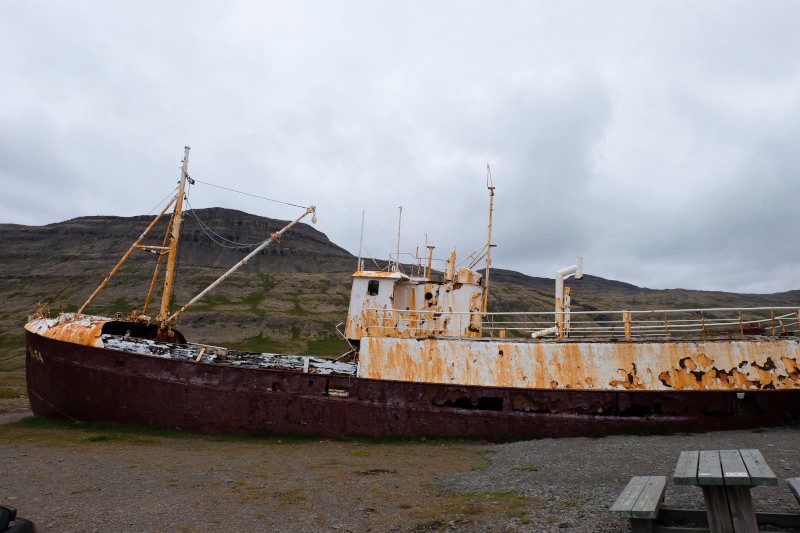
I’ll keep this simple: Stay on paths. Don’t chase wildlife. Take your trash.
And if you find yourself tempted to carve your name into a rock or build your own little stone tower, just don’t. Icelandic nature isn’t a souvenir shop, and every little footprint adds up. Stick to designated trails, keep food waste packed away, and resist the urge to get that “risky drone shot” if it means disturbing nesting birds. It’s basic stuff, but absolutely vital when you’re travelling through places this wild and delicate.
What to Pack for the Westfjords
Essentials for Campervan Travel
A warm and reliable sleeping bag is a must, even in summer, as nights can get pretty nippy. A full cooking setup: gas stove, pots, utensils, and that all-important coffee pot (included in all our campervan rentals).
A solid headlamp for midnight toilet missions or stargazing (just don’t mix the two) also helps. Waterproof everything: jackets, boots, bags, and ideally your mood (keep the sass within if possible). Also throw in a quick-dry towel, a thermos, and a good book for those nights the rain insists on reading you a bedtime story.
Clothes for All Conditions

Layers are life. Write it down, repeat it like a mantra at your local bus stop, or get it tattooed, but please remember this.
Start with a breathable base layer to wick moisture when you’re hiking or dealing with Iceland’s famous wind-that-comes-from-every-direction.
Add a fleece or insulated mid-layer to trap warmth, and top it off with a reliable waterproof shell that is hardy enough to take ont the mighty downpour of our chaotic Arctic skies.
Bring wool socks (lots of them) and gloves, even in July. It’s also worth packing a hat that covers your ears, thermal leggings for evenings (yes, even for men), and always something windproof for those stunning-but-freezing photo stops.
Offline Maps & Apps
Download Google Maps offline so you’re not relying on a signal that ghosts you the second you need it most. Also consider donwloading the 112 Iceland app that lets you send your location to emergency services at the press of a button, even with no signa.
If you’re feeling extra cautious (or just love an app to hike light, like me), maps.me is another solid offline option with walking trails and remote spots not always covered by the likes of Mr Google.
How Many Days Should I Spend in the Westfjords?
I’d recommend an absolute minimum of 3 days. That gives you just enough time to visit the main attractions without feeling like you’re in a reality show called “Race Around the Westfjords.”
Allocating 5 days lets you slow down, enjoy the winding roads, and maybe even soak in a hot spring without anxiously worrying about your schedule too much (only a bit).
But, if you can allocate the time, then I’d suggest that 7 days gives you the sweet spot. You’ll have time to explore the outer fjords, detour into hidden corners, linger over a lunch with a view (perhaps by an unmapped waterfall), and still have space in your itinerary for a puffin-induced shaky legs detour out by Látrabjarg.
Can You Visit the Westfjords in Winter?

Technically, yes. There are a few brave souls who do it. But realistically, no. Heavy snowfall, frequent road closures, avalanche-prone areas, and just a few hours of daylight make winter travel in the Westfjords more of an struggle than a holiday.
Even major routes can be impassable for days at a time, and key services like petrol stations or open campsites are few and far between. If you’re not driving one of our 4×4 campers and have strong Arctic winter driving experience as well as a backup plan for your backup plan, it’s best to leave this region for the warmer months (way more enjoyable too).
Are the Roads Paved?
Most of the main. But, also many are gravel. And not the nice, well-packed kind either. Instead, we’re talking bone-rattling, coffee-spilling, pothole-dodging adventures that feel more like a low-speed rollercoaster than a super fun road trip.
You might even find yourself doing 20 km/h with both hands locked at ten and two while your travel buddy (usually the other half) negotiates with the seatbelt as some kind of odd yet comforting distraction.
Will I See the Northern Lights?

In winter, yes, probably. But only if the sky is clear, the solar activity is strong, and you haven’t accidentally parked next to the only cloud in Iceland that night. The odds are decent, especially in the Westfjords where you’ll find some of the darkest skies in the country. It’s also far easier in this region to escape streetlights glare, and oppositely to Reykjavík there are essentially no tour buses either, just you, your campervan, and the dancing skies above (if you’re lucky!)
Use aurora forecast tools like the Vedur.is northern lights tracker to help improve your chances with the lovely simplified Kp number forecast (1 – weak, 3 – you’ll see something nice, 8 – oh my god life is complete!)
Final Thoughts: Why the Westfjords Belong on Your Iceland Itinerary
The Westfjords iis wild, fun, a great road trip, but even better than that, it’s a wonderful challenge and adventure. It’s a reminder that the best places often require a little extra effort. But that effort? It’s worth it even just to spend some time at Dynjandi from my perspective after exploring the region.
The journey is also far more awesome in a campervan. With a bed on wheels and the open road ahead, you’re free to chase uncharted waterfalls, base-diving puffins, or just that feeling of being somewhere utterly wild. So take the detour. Trust me. It’s the road less travelled for a reason. So, follow that road and you won’t regret it.
Back